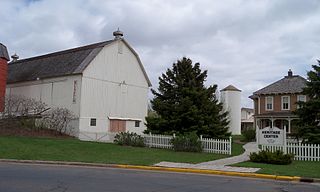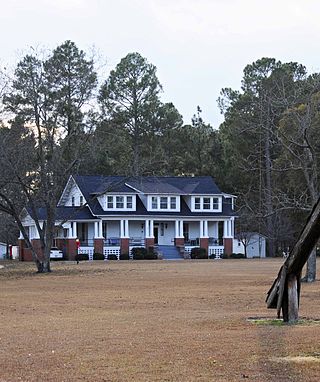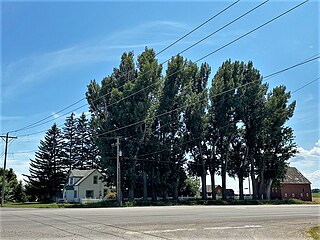Silk Hope, in Chatham County, North Carolina, United States, is a farm community centered on a school, a volunteer fire department, several country churches, and many historical farmsteads. Some residents who work in Cary, Chapel Hill, and Research Triangle Park have established "country" homes here. Its ZIP Code is 27344.

The following is a list of Registered Historic Places in Oakland County, Michigan.
This National Park Service list is complete through NPS recent listings posted February 9, 2024.

The Thorstein Veblen Farmstead is a National Historic Landmark near Nerstrand in rural Rice County, Minnesota. The property preserves the childhood home of Norwegian-American economist and sociologist Thorstein Veblen (1857-1929), best known for his 1899 treatise The Theory of the Leisure Class.

The Pryor Brock Farmstead is a place on the National Register of Historic Places just west of Zionsville, Indiana, comprising 4.9 acres (20,000 m2) of what was once a 200-acre (0.81 km2) farm. It was placed on the Register, June 27, 2008, due to its role in the agricultural history of Eagle Township, Boone County, Indiana. Pryor Brock Farmstead, with its carpenter's rendering of Italianate architecture, is the best representation of the prosperous agricultural setting around Zionsville/Eagle Township during its time of significance (1870-1920), the "golden age" of Hoosier agriculture.
Heritage Hill State Historical Park, is a 56-acre open-air museum located in Allouez, Wisconsin. A Wisconsin state park, the site is operated by a non-profit organization called the Heritage Hill Corporation in partnership with the Wisconsin Department of Natural Resources (DNR). The Heritage Hill Corporation operates, maintains and develops the park under terms of a lease with the DNR.
Carpenter House may refer to:

The Daniel McBean Farmstead is a historic home in Wellsville, Ohio. The farmstead was built in 1846 by Daniel McKay and was added to the National Register of Historic Places on January 12, 2005.

The Franklin Harris Farmstead is a historic farm complex located outside the village of Salem in Columbiana County, Ohio, United States. Once home to a prominent former soldier, the farmstead includes a high-style farmhouse from the 1890s, and it has been named a historic site.

The Charles C. Fitch Farmstead is a historic farm property located in Eugene, Oregon. It was listed as a historic district on the National Register of Historic Places (NRHP) on June 16, 1989.

The Littell-Lord Farmstead, located in Berkeley Heights, Union County, New Jersey, United States, is a pastoral site reminiscent of Union County's agricultural past. It was built around 1760 and added to the National Register of Historic Places on March 7, 1979. It currently serves as the home and public museum of the Berkeley Heights Historical Society.

The Louden Machinery Company was an American engineering, manufacturing and design company based in Fairfield, Iowa. Founded by William Louden, the company in its early years manufactured and sold the patented hay carrier that he invented in 1867. The company later expanded into a wide variety of farm equipment and, in 1906, began an Architecture Department that reportedly designed more than 25,000 barns from 1906 to 1939. During World War I, Louden's monorail equipment carrier began to be applied to industrial and military applications. By the 1920s, much of the company's revenues were derived from industrial applications of its monorail equipment carriers.

The Marcus Sears Bell Farm, also known as the Bell-Tierney Farmstead, is located in New Richmond, Wisconsin, United States. It was added to the National Register of Historic Places in 1988.

John Hayes Farmstead, also known as Cotton Press Farm and John Hayes House, is a historic home and farm located near Latta, Dillon County, South Carolina. The main house was built in 1791, later extensively renovated and expanded as an American Craftsman / Bungalow house in 1915. It is still a working farm, producing tobacco, corn, grains, and soybeans, and in 1988 was recognized by the U.S. Department of Agriculture as a Bicentennial Farm. Also on the property are a sweet potato curing house, three barns, smokehouse, wash house, and pump house.

The Widner–Magers Farm is a historic farm property in rural Mississippi County, Arkansas. It is located at 3398 Arkansas North Highway 181, north of the town of Dell. The farmstead is set on a parcel of 1.3 acres (0.53 ha), surrounded by about 100 acres (40 ha) of land generally cultivated in cotton. The farmstead includes a number of historically significant agricultural outbuildings, built between the 1910s and 1930s, as well as a heavily altered 1930s farmhouse. The property is a fine local example of a subsistence-level cotton farming operation from the era of the Great Depression, and was listed on the National Register of Historic Places in 2007.
The Chris Poldberg Farmstead is a collection of historic domestic and agricultural buildings located southeast of Jacksonville, Iowa, United States. It was listed on the National Register of Historic Places in 1991. The historic importance of the farmstead is its association with stock farming, an important industry associated with Danish immigrants who settled in Shelby and Audubon counties from 1865 to 1924. The historic designation includes the two-story, foursquare, frame house (1907); the Midwest three portal barn (1912); hog house (1914); poultry house (1914); machine shed (1914); and cob house (1914). The house was built by Carl V. Andersen, and the barn, machine shed, and hog house by Jacksonville carpenter gangs.
The DeFries House, Barn and Carpenter Shop are a collection of historic buildings located north-west of Andrew, Iowa, United States. They are three of over 217 limestone structures in Jackson County from the mid-19th century, of which 101 were houses, nine were barns, and 36 were other farm-related buildings. The stones used in the construction are of various sizes and shapes and laid in courses. The double end chimneys on the house are found on only two other stone houses in the county, and the DeFries and Thomas Slye houses have them constructed in brick. Also similar to the Slye house is the use of jack arches instead of lintels above the windows and doors. It is possible that both houses were constructed by the same stonemason. While the stonemason for the Syle house is unknown, John Christoph "Christian" Blessing, who was trained in his native Germany, built this collection of buildings for the DeFries family. He completed the house in 1858 and the horse barn in 1862. The carpenter shop was built in either 1858 or 1862.

The West View Farm is a historic farm property on Hastings Road in Waterford, Vermont. The farm is unique for its distinctive round barn, built in 1903 to a design by St. Johnsbury architect Lambert Packard, and surviving 19th-century corn crib and smokehouse. The property was listed on the National Register of Historic Places in 1995. It includes a round barn.

The Langford and Lydia McMichael Sutherland Farmstead is a farm located at 797 Textile Road in Pittsfield Charter Township, Michigan. It was listed on the National Register of Historic Places in 2006. It is now the Sutherland-Wilson Farm Historic Site.

The Oscar and Christina Beckman Farmstead, in Bonneville County, Idaho near Idaho Falls, Idaho, was built in 1896. It was listed on the National Register of Historic Places in 1991. The listing included nine contributing buildings on 80 acres (32 ha).
















